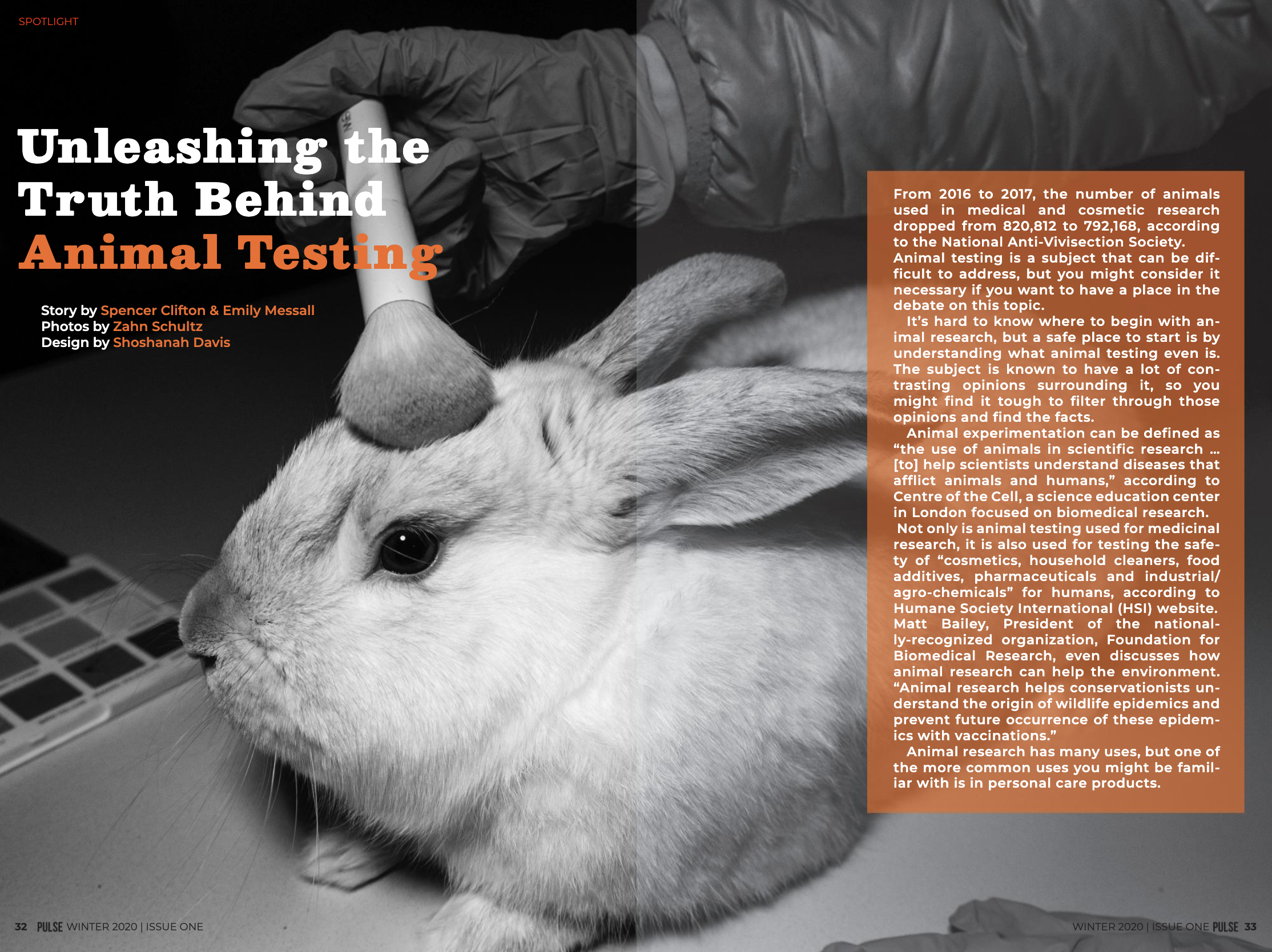Unleashing the Truth Behind Animal Testing
Story by Spencer Clifton & Emily Messall | Photos by Zahn Schultz | Design by Shoshannah Davis
From 2016 to 2017, the number of animals used in medical and cosmetic research dropped from 820,812 to 792,168, according to the National Anti-Vivisection Society. Animal testing is a subject that can be dif - ficult to address, but you might consider it necessary if you want to have a place in the debate on this topic.
It’s hard to know where to begin with animal research, but a safe place to start is by understanding what animal testing even is. The subject is known to have a lot of contrasting opinions surrounding it, so you might find it tough to filter through those opinions and find the facts.
Animal experimentation can be defined as “the use of animals in scientific research … [to] help scientists understand diseases that afflict animals and humans,” according to Centre of the Cell, a science education center in London focused on biomedical research. Not only is animal testing used for medicinal research, it is also used for testing the safe - ty of “cosmetics, household cleaners, food additives, pharmaceuticals and industrial/ agro-chemicals” for humans, according to Humane Society International (HSI) website. Matt Bailey, President of the nationally-recognized organization, Foundation for Biomedical Research, even discusses how animal research can help the environment. “Animal research helps conservationists understand the origin of wildlife epidemics and prevent future occurrence of these epidemics with vaccinations.”
Animal research has many uses, but one of the more common uses you might be familiar with is in personal care products.
Animal Research in Personal Care Products
Products such as makeup, body wash, toothpaste and shampoo are tested on animals for a variety of different reasons. One of the main reasons for using animals in cosmetic research is to test the safety of products for humans, according to HSI.
There are a number of different tests done on animals that can help to determine the safety of products “includ[ing] skin and eye irritation tests,” repeated oral feeding studies that “look for signs of general illness or specific health hazards,” and tests in which animals ingest chemicals to determine how much can safely be consumed before death, according to HSI.
Yet, there are some brands that offer products safe for use, without utilizing animal testing in the production process.
A representative from the well-known cosmetics company, Wet ‘n Wild, released in a statement to PULSE Magazine that “In addition to not testing on animals, approximately 80% of products are vegan, and we will be 100% vegan in the near future.” Wet ‘n Wild adds that they work to provide customers with “high-quality, affordable products they can feel good about buying and wearing.”
For some, buying cruelty-free products can become an influential part of their morals, while others look towards the medical benefits that animal research can bring.
The website for The Foundation for Biomedical Research (FBR) mentions that there are guidelines for the care and use of lab animals in experimental research. Some of these guidelines include that living spaces must be designed to meet the needs of each animal, temperatures must be monitored, the air is clean and lab animals eat and drink well under the supervision of a nutritionist, says the FBR.
However, not everyone agrees with the use of animal testing for these purposes.
Vice President of People for the Ethical Treatment of Animals (PETA), Alka Chanda says, “PETA operates under the credo that animals are not ours to experiment on, eat, wear, use for entertainment, or exploit in any other way … PETA’s position is one that is based in science and the recognition that there are no morally relevant biological or cognitive qualities that humans have, that animals do not.”
There are two sides to how people view animal testing in personal care products. Now that you’ve learned a little bit more, you can decide for yourself whether to look for the cruelty-free label or not before you choose your next makeup product or new bottle of shampoo you’ve been needing.
Research and Scientific Advancements
Testing on animals goes far beyond safety procedures for consumer items. One aspect of animal testing that you may not see often is its contribution to medical advancements.
Associate Biology Professor, April Binder, explains, “There are a number of mouse models for certain human diseases that are very beneficial to studying those diseases and developing medicines and treatments for humans.”
According to the FBR, most of the advancements that are seen in medicine are due to the help of animal testing. “For example, cancer testing can be done on animal models and we can see certain cancer treatments reducing tumor sizes,” says Binder.
Bailey adds that, “Animal research has led to virtually every medical breakthrough.” Among these breakthroughs, Bailey notes the discovery of a smallpox vaccine, antimalarial drugs, treatments and medical devices for heart diseases, cataracts and pre-clinical research.
Regulations
As you think about where you stand on the use of animals in research, regulations are also an important aspect to keep in mind.
Many may think that there are no regulations when it comes to animal research, but the FBR’s website states that “The Animal Welfare Act … sets high standards of care for lab animals with regard to their housing, feeding, cleanliness, ventilation and medical needs.”
Jim Newman, Communications Director at Americans for Medical Progress (AMP) also mentions that, “The USDA is charged with enforcing the law. They have investigators who conduct surprise inspections of health research organizations.”
Companies who violate any part of the regulations put into place could face serious repercussions. Newman discusses that, “If [the investigators] find anything … these items are written up in a report that is publicly available. If a research organization has a serious infraction, they can be fined and then in extreme cases, they can be shut down.”
Federal regulations are enforced strongly in university campus settings as well. For example, CWU has an Institutional Animal Care and Use Committee that determines all requests for the use of animals in research. According to their website, their goals include, “reduc[ing] the number of animals used” as well as limiting any “discomfort they may experience.”
While there are regulations to animal research, it’s still up to you to decide whether or not purchasing products that are tested on animals interferes with your own moral compass.
Alternatives to Animals
While animals are not always necessary to use, they have been said to be helpful in determining the safety of a product for humans. You may be hard-pressed to find a person willing to take a pill or use a shampoo without knowing how it might affect them.
However, despite the fact that animal research has been around for many years, some companies, like Wet ‘n Wild, are starting to utilize cruelty-free alternatives that don’t involve any animals.
Newman elaborates that animals don’t have to be the number one go-to when looking to research the safety of a new product. “The research funding process requires scientists to prove why they must study animals and explain the benefits. If there are non-animal alternatives, they must prove in detail why those options will not work.”
Some of these alternatives to animal testing include: cell cultures, human tissues, computer models and volunteer studies, according to the Cruelty Free International website.
Refusing to take part in animal testing, some companies utilize these alternatives and have taken a stand against this issue.
Procter & Gamble, the parent company to houshold name brands such as Dawn Dish Soap and Charmin, released a statement to PULSE Magazine, stating that, “We believe that eliminating animal testing is the right thing to do, therefore we’ve invested more than $410 million in developing alternative, non-animal testing methods and then getting them accepted by regulators around the world.”
If you’re thinking of going cruelty-free, you could take comfort in knowing that there are many alternatives to brands and products that use animal testing. On the other hand, if you decide going cruelty-free isn’t for you, keep in mind that not every test can be done using humans or alternatives yet.
Organizations With Purpose
Despite the possible benefits that animal testing has been said to provide to the medical world and other areas, various animal rights activists and nonprofit organizations continue to fight the practice of animal testing in America.
The Northwest Animal Rights Network (NARN) board member, Rachel Bjourk, states that, “As an animal rights organization, we advocate for the rights inherent to all sentient beings to live a full life, to be free, and not to be used and exploited.”
Bjourk claims that NARN opposes animal testing through different campaigns in order to spread awareness. “We engage in campaigns and other educational actions to expose, challenge, and alleviate the suffering, use and abuse of non-human animals.”
PETA’s efforts have also influenced significant changes to the way animal testing is regulated in America, according to Chanda.
“Since its inception 40 years ago, PETA has carried out eyewitness, or undercover, investigations in which people who are employed by PETA take employment at facilities where animals are used and abused,” says Chanda. These investigations eventually made their way to the supreme court and “led to the landmark 1985 amendments to the Animal Welfare Act.”
NARN and PETA are just two of the many organizations against animal testing, but it can also be important to look into the organizations that oppose it.
Bailey describes the FBR as “America’s most experienced, trusted and effective nonprofit organization dedicated to promoting public understanding and support for biomedical research.” As President of the FBR, Bailey highlights the role that animal research plays in “defeating illnesses that affect both people and animals.”
In addition to the FBR, Newman discusses AMP and how it is “a nonprofit, health research advocacy group that supports the advancement of human and animal medicine through responsible and highly-regulated research in animals [that] … informs the public about animal-based research through outreach programs.”
Newman also notes that the organization is, “supported by the nation’s top universities, private research facilities, research-related businesses, scientific and professional societies.”
When it comes down to it, no one can make the decision to go cruelty-free or not except you. After gaining some insight on both sides of the same coin, and maybe doing some other outside research, hopefully you feel informed enough to make an educated decision on where you stand with the issue of animal testing.




